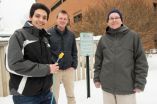(Press-News.org) Selecting a Chevy Volt, Tesla Model S, Nissan Leaf — or one of many other new models — shoppers in the United States bought more than 96,000 plug-in electric cars in 2013. That's a tiny slice of the auto market, but it's up eighty-four percent from the year before. By 2020, the International Energy Agency forecasts, there will be 20 million electric vehicles on the world's roads, many of them plug-ins.
This is good news in terms of oil consumption and air pollution. But, of course, every plug-in has to be, well, plugged in. And this growing fleet will put a lot of new strain on the United States' aging electrical distribution systems, like transformers and underground cables, especially at times of peak demand — say, six in the evening when people come home from work.
How to manage all these cars seeking a socket at the same time — without crashing the grid or pushing rates to the roof — has some utilities wondering, if not downright worried.
Now a team of scientists from the University of Vermont have created a novel solution, which they report on in the forthcoming March issue of IEEE Transactions on Smart Grid, a journal of the Institute of Electrical and Electronics Engineers.
"The key to our approach is to break up the request for power from each car into multiple small chunks — into packets," says Jeff Frolik, a UVM engineer and co-author on the new study.
By using the nation's growing network of "smart meters" — a new generation of household electric meters that communicate information back-and-forth between a house and the utility — the new approach would let a car charge for, say, five or ten minutes at a time. And then the car would "get back into the line," Frolik says, and make another request for power. If demand was low, it would continue charging, but if it was high, the car would have to wait.
"The vehicle doesn't care. And, most of the time, as long as people get charged by morning, they won't care either," says UVM's Paul Hines, an expert on power systems and co-author on the study. "By charging cars in this way, it's really easy to let everybody share the capacity that is available on the grid."
Taking a page out of how radio and internet communications are distributed, the team's strategy will allow electric utilities to spread out the demand from plug-in cars over the whole day and night. The information from the smart meter prevents the grid from being overloaded. "And the problem of peaks and valleys is becoming more pronounced as we get more intermittent power — wind and solar — in the system," says Hines. "There is a growing need to smooth out supply and demand."
At the same time, the Vermont teams' invention — patent pending — would protect a car owner's privacy. A charge management device could be located at the level of, for example, a neighborhood substation. It would assess local strain on the grid. If demand wasn't too high, it would randomly distribute "charge-packets" of power to those households that were putting in requests.
"Our solution is decentralized," says Pooya Rezaei, a doctoral student working with Hines and the lead author on the new paper. "The utility doesn't know who is charging."
Instead, the power would be distributed by a computer algorithm called an "automaton" that is the technical heart of the new approach. The automaton is driven by rising and falling probabilities, which means everyone would eventually get a turn — but the utility wouldn't know, or need to know, a person's driving patterns or what house was receiving power when.
But what if you come home from work and need to charge your plug-in right away to get to your kid's big basketball game? "We assumed that drivers can decide to choose between urgent and non-urgent charging modes," the scientists write. In the urgent mode the vehicle requests charge regardless of the price of electricity. In this case, the system gives this car the best odds of getting to the front of the line, almost guaranteeing that it will be charged as soon as possible — but at full market rates instead of the discount rate that would be used as an incentive for those opting-in to the new approach.
Why put plug-in cars on "packetized" demand instead of all the other electric demands in a house? Because the new generation of car chargers, so-called "Level 2 PEV chargers" are likely to be the biggest power load in a home. "The load provided by an electric vehicle and the load provided by a house are basically equivalent," says Frolik. "If someone gets an electric vehicle it's like adding another house to that neighborhood."
Imagine a neighborhood where everyone buys a plug-in car. Demand doubles, but it's over the same wires and transformers. Concern about overload in this kind of scenario has led some researchers and utilities to explore systems where the company has centralized control over who can charge when. This so-called "omniscient centralized optimization" can create a perfectly efficient use of the available power — in theory.
But it also means drivers have to either be willing to provide information about their driving habits or set schedules about when they'll charge their car. This rubs against the grain of a century's worth of understanding of the car as a tool of autonomy.
Others have proposed elaborate online auction schemes to manage demand. "Some of the other systems are way too complicated," says Hines, who has extensive experience working with actual power companies. "In a big city, a utility doesn't want to be managing millions of tiny auctions. Ours is a much simpler system that gets the job done without overloading the grid and gets people what they want the vast majority of the time."
INFORMATION:
Will plug-in cars crash the electric grid?
Vermont engineers invent new method for managing growing fleet
2014-02-21
ELSE PRESS RELEASES FROM THIS DATE:
Reducing HIV transmission among drug injectors lowers AIDS mortality in heterosexuals
2014-02-21
Although community network studies show that sexual relationships occur between members of "risk groups" -- men who have sex with other men (MSM), people who inject drugs (PWID), non-injection drug users (NIDU) -- and heterosexuals, researchers at New York University's Center for Drug Use and HIV Research (CDUHR) note that little research has been done to help explain how HIV epidemics and programs in one population affect others and how to reduce the risks of transmission.
A recent study conducted by researchers from CDUHR, led by Samuel R. Friedman, Director of both ...
Promising cervical cancer study
2014-02-21
(Phoenix , Ariz. Feb 21, 2014) -- Research on cervical cancer performed by a physician at the University of Arizona Cancer Center at St. Joseph's Hospital and Medical Center has been published in the New England Journal of Medicine. The multi-site research project by Bradley J. Monk, MD, is expected to change the standard of care for women with advanced cervical cancer.
The featured research revealed that women with advanced cervical cancer live about four months longer with the combined use of bevacizumab (Avastin®) and chemotherapy compared to chemotherapy alone. ...
Tracking catalytic reactions in microreactors
2014-02-21
A pathway to more effective and efficient synthesis of pharmaceutical drugs and other flow reactor chemical products has been opened by a study in which for the first time the catalytic reactivity inside a microreactor was mapped in high resolution from start-to-finish. The results not only provided a better understanding of the chemistry behind the catalytic reactions, they also revealed opportunities for optimization, which resulted in better catalytic performances. The study was conducted by a team of scientists with the U.S. Department of Energy (DOE)'s Lawrence Berkeley ...
Air Force aircraft returned from Vietnam identified as postwar source of Agent Orange contamination
2014-02-21
Amsterdam, February 21, 2014 – From 1971-1982 Air Force reservists, who flew in about 34 dioxin-contaminated aircraft used to spray Agent Orange and returned to the US following discontinuation of the herbicide spraying operations in the Vietnam War, were exposed greater levels of dioxin than previously acknowledged, according to a study published today in Environmental Research.
"These findings are important because they describe a previously unrecognized source of exposure to dioxin that has health significance to those who engaged in the transport work using these ...
Kessler Foundation MS researchers find task meaningfulness influences learning and memory
2014-02-21
West Orange, NJ. February 21, 2014. Kessler Foundation researchers have found that among persons with multiple sclerosis, self-generation may be influenced by variables such as task meaningfulness during learning and memory. They also found that type of task (functional versus laboratory) had a significant effect on memory.
This is the first controlled investigation of therapeutic and patient-specific factors that supports the inclusion of self-generation in cognitive rehabilitation. The study was published in the January issue of Neuropsychological Rehabilitation: An ...
If you think you have Alzheimer's, you just might be right, study suggests
2014-02-21
Lexington, Ky. -- (Feb. 20, 2014) -- a recent study suggests that self-reported memory complaints might predict clinical memory impairment later in life.
Erin Abner, Ph.D, an assistant professor at the University of Kentucky's Sanders-Brown Center on Aging, asked 3,701 men aged 60 and higher a simple question: "Have you noticed any change in your memory since you last came in?"
That question led to some interesting results. "It seems that subjective memory complaint can be predictive of clinical memory impairment," Abner said. "Other epidemiologists have seen similar ...
Researchers look to reduce hep C infections for injecting drug user
2014-02-21
Despite a number of social/behavioral intervention and educational programs, the spread of hepatitis C (HCV) in people who inject drugs (PWIDs) remains a chronic problem. Now, researchers affiliated with New York University's Center for Drug Use and HIV Research (CDUHR) are focusing on intervention strategies that highlight the lesser-known dangers of HCV transmission through the sharing of other injection equipment such as cookers, filters, drug-dilution water and water containers.
Their article, "The Staying Safe Intervention: Training People Who Inject Drugs in ...
Optimizing custody is child's play for physicists
2014-02-21
Physics can provide insights into societal trends. Problems involving interactions between people linked in real-life networks can be better understood by using physical models. As a diversion from his normal duties as a theoretical physicist, Andrés Gomberoff from the Andres Bello University in Santiago, Chile, set out to resolve one of his real-life problems: finding a suitable weekend for both partners in his recomposed family to see all their children at the same time. He then joined forces with a mathematician and a complex systems expert. This resulted in a study ...
Report reveals significant increase in overdoses involving heroin in Kentucky
2014-02-21
LEXINGTON, Ky. (Feb. 21, 2014) -- A new report from the Kentucky Injury Prevention and Research Center (KIPRC) reveals the prevalence and charges associated with drug overdose in the Bluegrass state. The report, "Drug Overdose Deaths, Hospitalizations, and Emergency Department Visits in Kentucky, 2000-2012", analyzes overdose morbidity and mortality among Kentucky residents and documents the enormous societal and financial toll on the Commonwealth's population. KIPRC, located in the UK College of Public Health, is a bona fide agent for the Kentucky Department for Public ...
Newly discovered marsupial the victim of fatal attraction
2014-02-21
A QUT mammalogist has discovered a highly sexed mouse-like marsupial in Queensland's Springbrook National Park.
The Black-tailed Antechinus was found in the high-altitude regions of the World Heritage Area.
It's the third new species in the genus Antechinus Dr Andrew Baker's research team has discovered in the past two years, all from south-east Queensland.
Dr Baker said he suspected the rare, Black-tailed Antechinus was a separate species when he and his team came across it last May because it had distinctive yellow-orange markings around its eyes and on its rump, and ...
LAST 30 PRESS RELEASES:
Numbers in our sights affect how we perceive space
SIMJ announces global collaborative book project in commemoration of its 75th anniversary
Air pollution exposure and birth weight
Obstructive sleep apnea risk and mental health conditions among older adults
How talking slows eye movements behind the wheel
The Ceramic Society of Japan’s Oxoate Ceramics Research Association launches new international book project
Heart-brain connection: international study reveals the role of the vagus nerve in keeping the heart young
Researchers identify Rb1 as a predictive biomarker for a new therapeutic strategy in some breast cancers
Survey reveals ethical gaps slowing AI adoption in pediatric surgery
Stimulant ADHD medications work differently than thought
AI overestimates how smart people are, according to HSE economists
HSE researchers create genome-wide map of quadruplexes
Scientists boost cell "powerhouses" to burn more calories
Automatic label checking: The missing step in making reliable medical AI
Low daily alcohol intake linked to 50% heightened mouth cancer risk in India
American Meteorological Society announces Rick Spinrad as 2026 President-Elect
Biomass-based carbon capture spotlighted in newly released global climate webinar recording
Illuminating invisible nano pollutants: advanced bioimaging tracks the full journey of emerging nanoscale contaminants in living systems
How does age affect recovery from spinal cord injury?
Novel AI tool offers prognosis for patients with head and neck cancer
Fathers’ microplastic exposure tied to their children’s metabolic problems
Research validates laboratory model for studying high-grade serous ovarian cancer
SIR 2026 delivers transformative breakthroughs in minimally invasive medicine to improve patient care
Stem Cell Reports most downloaded papers of 2025 highlight the breadth and impact of stem cell research
Oxford-led study estimates NHS spends around 3% of its primary and secondary care budget on the health impacts of heat and cold in England
A researcher’s long quest leads to a smart composite breakthrough
Urban wild bees act as “microbial sensors” of city health.
New study finds where you live affects recovery after a hip fracture
Forecasting the impact of fully automated vehicle adoption on US road traffic injuries
Alcohol-related hospitalizations from 2016 to 2022
[Press-News.org] Will plug-in cars crash the electric grid?Vermont engineers invent new method for managing growing fleet


